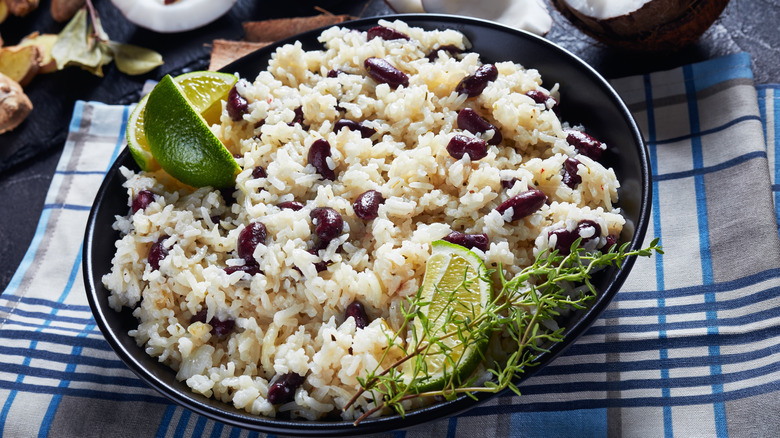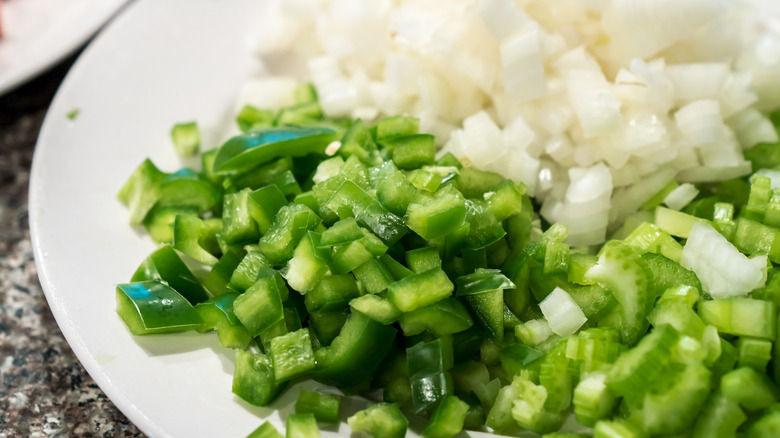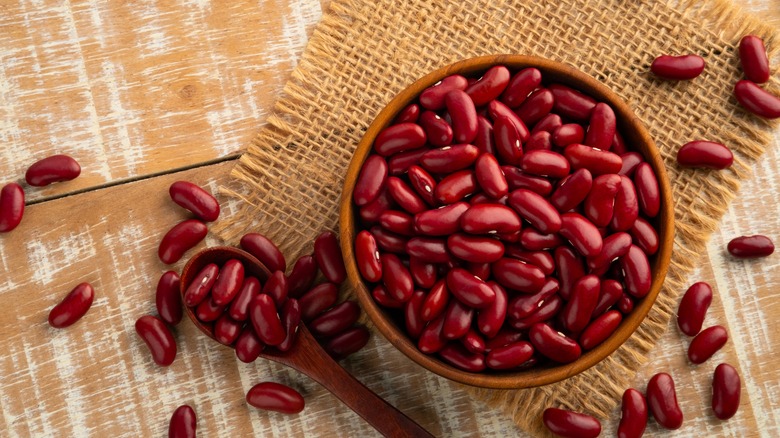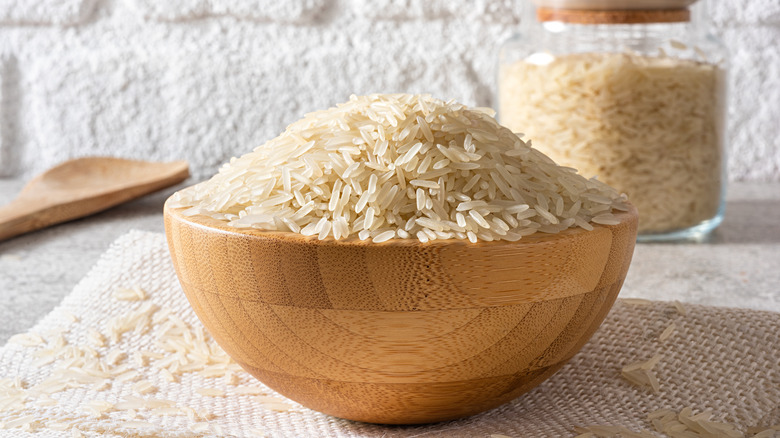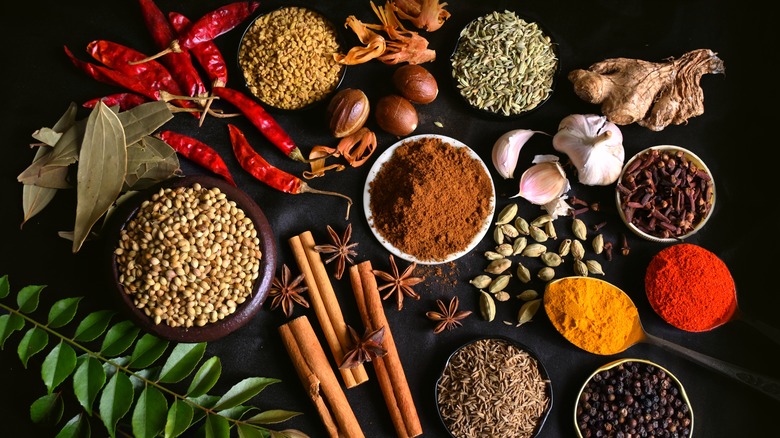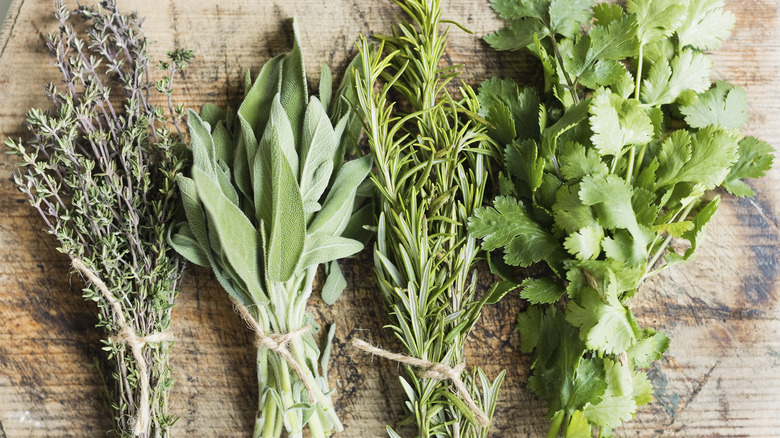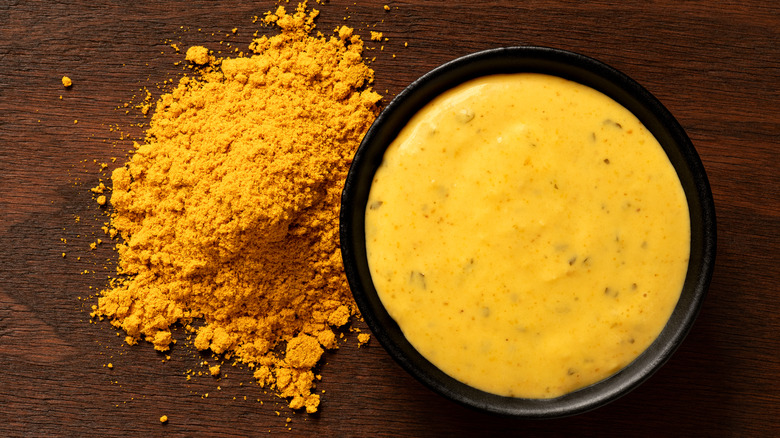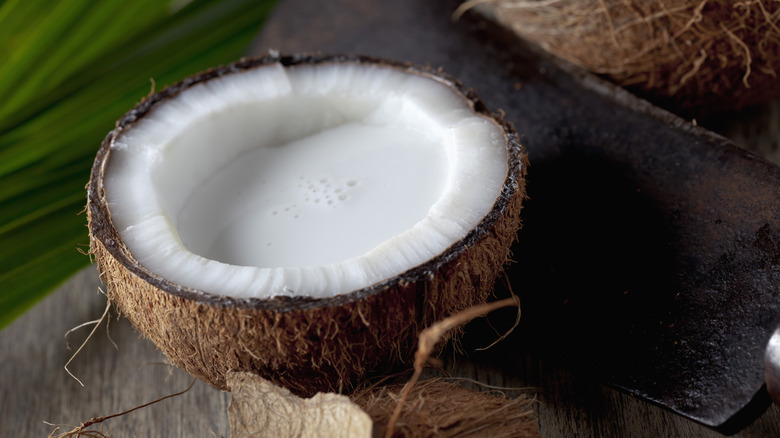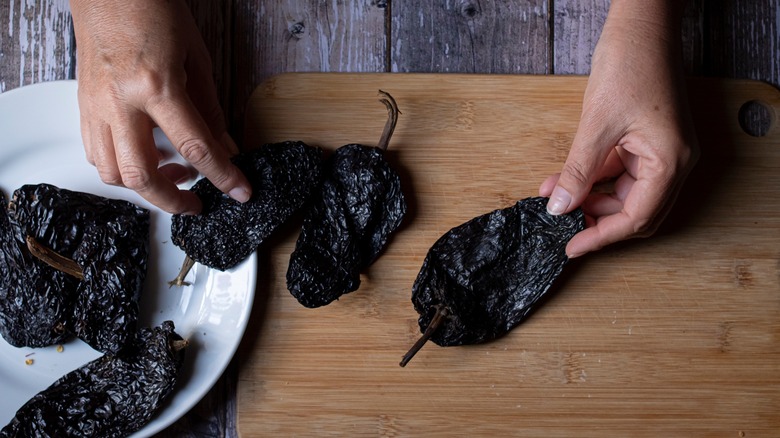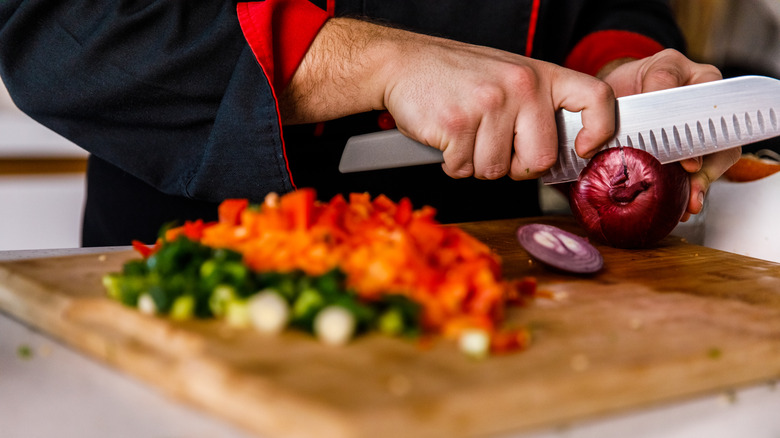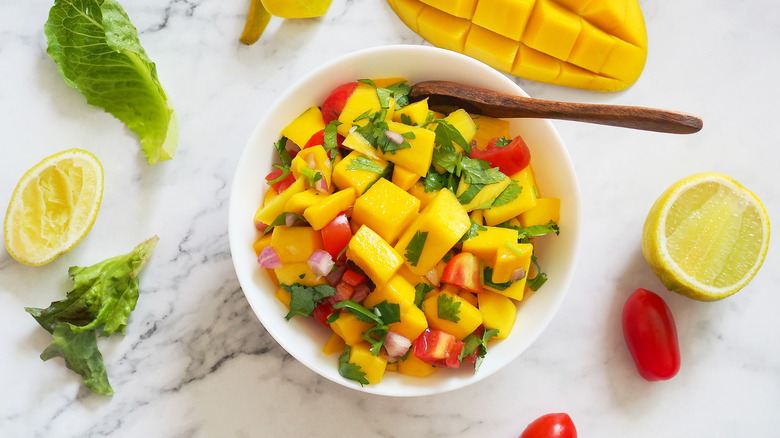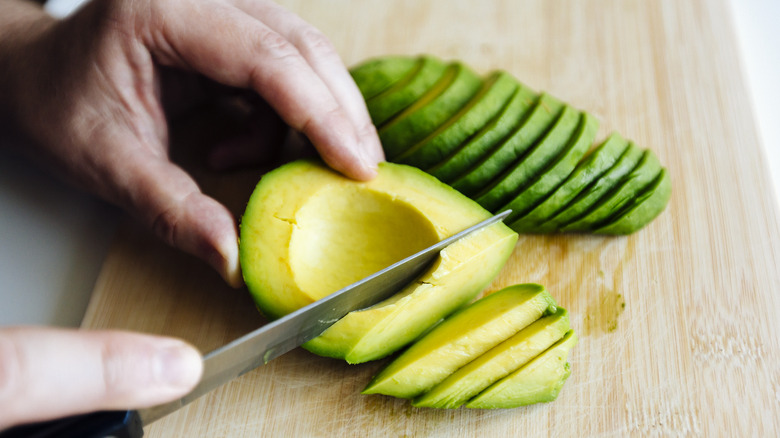12 Simple Ways Chefs Upgrade Basic Beans And Rice
A bean and rice dish is a classic staple enjoyed in various forms across many cultures. It's a common meal for a reason — the ingredients are cheap yet nutritious and taste good even with just basic aromatics and seasonings. While beans and rice are delicious in the simplest form, the dish can get boring after a while. Luckily, you can elevate this ultimate pairing with just a few culinary tricks.
Professional chefs are masters of small additions and technique tweaks that can transform dishes. I wanted to learn how they turn beans and rice into something truly special and worthy of restaurant prices. So, I interviewed two chefs — one an expert in Dominican food and the other in a range of Caribbean cuisines.
Armed with their tips and tricks, I've expanded on some of the simple ways chefs upgrade basic beans and rice. From aromatic spices to tasty toppings, these chef-approved tips will help you take some of the simplest ingredients around and make them taste restaurant-quality.
Use aromatics
Aromatics are ingredients that release fragrant oils and flavors when heated. Generally, chefs make use of them at the beginning of the cooking process. These ingredients include onions, garlic, celery, carrots, and ginger. They form the flavor foundation of many dishes across various cuisines. When you use the Cajun Holy Trinity in a dish, or a French mirepoix, you're using aromatics. These are the building blocks chefs use to make their beans and rice taste amazing.
For beans and rice, aromatics are essential because they add depth, complexity, and richness to what might otherwise be a relatively plain dish. Aromatic ingredients infuse their flavors into these staple ingredients, leveling them up. To make great rice and beans, "basic items cannot be forgotten like onions, bay leaves, and garlic," remarks Andre Blasczak, executive chef at The Westin Grand Cayman Seven Mile Beach Resort & Spa.
They might be the basic ingredients in these kinds of dishes, but they're essential. Try to make beans and rice without them and your finished dish will be bland. What's more, you can adjust the types of aromatics used depending on the flavor profile you want from the finished dish.
Try dried beans instead of canned
Want a simple way to upgrade your beans and rice? Use dried beans instead of canned ones. When you cook beans from scratch, you have greater control over the cooking process, so it's easier to get the flavor and texture you want. You can infuse them with aromatics and seasonings from the start. Using dried beans also lets you cook them to the perfect consistency for your recipe. This is particularly important in bean and rice dishes, where you want the beans to hold their shape without becoming mushy. That's before we mention that beans cooked from dry just taste better.
For many chefs, using dried beans is a must. Chef Yesenia Ramdass, owner of HAAM in Williamsburg says that she's never been too fussy about where she sources her beans, but "what does matter is that they are dry beans and not canned."
"Dried beans are the best option as long as we follow all the steps, like soaking them in water the day before and slow cooking them after," says chef Andre Blasczak. "Through this process, the flavors always will be better and natural compared to canned ones and you avoid the artificial conservation substances found in canned products."
While using dried beans takes time, the extra effort is worthwhile for many. That said, if you're new to cooking beans from scratch, there is a learning curve. You might need some expert tips and techniques for cooking beans.
Choose a higher quality rice than usual
If you've been using the cheapest rice you can find at your local grocery store, you can improve your beans and rice by opting for something higher quality. The texture of high-quality rice is normally better than the cheap stuff. It's more likely to cook evenly, with each grain remaining separate and fluffy rather than becoming mushy or clumping together. You might also notice a difference in flavor and the general quality of the product, such as having fewer broken grains in a pack.
"The level of quality will always be higher if you are using good quality products," says Andre Blasczak. So, quality rice can make all the difference. However, the type of rice can also affect the finished dish. For instance, "if you are looking to make it stickier, my recommendation would be to use jasmine rice," Blasczak suggests.
However, not all chefs agree that rice quality makes a huge difference to the finished dish. "You can always use higher quality ingredients," Yesenia Ramdass remarks. "However, when making rice, it comes down to how it's cooked." No amount of pricey rice will make up for a dish that's poorly cooked.
Add spices
There's a reason why any keen cook has a whole pantry shelf full of spices. And, professional kitchens often have even more. Spices add depth and complexity to food, bringing new flavors into play. That's why they're essential for upgrading basic beans and rice. Spices can also help balance the earthiness of beans and the starchiness of rice, so the flavor profile is more well-rounded.
Chef Andre Blasczak names cumin as his go-to spice for beans and rice. However, there's a whole world of spices and spice blends out there. The best spices for the dish depends on the cuisine you're drawing inspiration from. In Latin American cooking, cumin, coriander, smoked paprika, and chili powder are common additions. For Indian-inspired dishes, spices like turmeric, coriander, cumin, and garam masala can transform beans and rice. In Caribbean cuisine, allspice is used in Jamaican rice and peas (along with non-spice seasonings like thyme and Scotch bonnet chiles).
You can experiment with different spice combinations to create a variety of flavors from the same basic ingredients. This versatility makes beans and rice an excellent canvas for exploring different cuisines and developing your own recipes. The timing of adding spices can also impact the final flavor. Some spices benefit from being lightly toasted in oil at the beginning of cooking to release their flavors, while others are best added towards the end so they don't lose their flavorful punch.
Use fresh herbs
It's just a simple addition but fresh herbs can significantly elevate beans and rice. They provide a vibrant contrast to the earthy flavor of beans and the stodginess of the rice. Rather than ending up with a dish that tastes muddy or one-note, you get something that sings. And all you had to do was throw some fresh herbs on top.
"Yes, Yes, Yes!" Yesenia Ramdass of HAAM says when asked if fresh herbs improve beans and rice. "Cilantro is the key ingredient that makes up a sofrito to cook up beans," she says. Ramdass also adds that cilantro pairs well with rice in these kinds of dishes. Andre Blasczak, chef at The Westin Grand Cayman Seven Mile Beach Resort & Spa is another cilantro fan. "I like to use rough chopped fresh cilantro but just on top for the aroma-flavor freshness," he notes, saying that he tops the beans and rice with it right before serving.
You can also toy with using various other herbs if you're trying to move away from a classic beans and rice flavor profile. Parsley brings a clean, slightly peppery taste that works well in Mediterranean-style dishes. Basil has a sweet, peppery flavor with hints of anise, which is perfect for Italian-inspired beans and rice. You can also use a combination of herbs. For example, a mix of parsley, cilantro, and mint helps you finish a dish reminiscent of Middle Eastern cuisine.
Top with a curry cream sauce
What you top your rice and beans with makes all the difference. While there are all kinds of sauces and condiments that you could pour, drop, and drizzle on top to liven up a basic meal, making your own sauce is going to give you the most impressive results. And, chef Yesenia Ramdass has her own suggestion.
"In my restaurant HAAM, I often find myself throwing curry cream sauce over my rice and beans and the mix never disappoints," Ramdass tells us. She doesn't explain how she makes the sauce, but one possible way is by simmering curry paste or curry powder in heavy cream, cashew cream, or coconut milk until infused with flavor.
If you're wondering what curry powder is, it's a blend of spices that are common in Indian cuisine. That said, curry powder isn't an Indian invention. Rather, it's made for a Western audience. So, you might be better off with something more authentic, such as garam masala, or simply blending the spices yourself. Adding aromatics — such as ginger and garlic — would make this kind of sauce more flavorful. And, of course, you'll need to add salt and some form of acid for brightness, such as lime juice or lemon juice.
Add coconut milk to the cooking liquid
If you're cooking your beans and rice in water alone, you're missing out on an easy way to upgrade them. Using coconut milk in the cooking liquid gives you a creamy, flavorful dish that you won't forget any time soon. Chef Andre Blasczak notes that Jamaican versions of beans and rice — usually called rice and peas — sometimes use coconut milk. So, this can give your dish a Caribbean twist. However, you could also make Thai-inspired or Indian-inspired beans and rice with coconut milk, even if they're not authentic.
It's simple to make use of coconut milk in your beans and rice dishes. Just replace a third to half of the water in the recipe with coconut milk, depending on how coconutty you want it to taste. You might think that more always equals better, but using coconut milk alone as the cooking water can affect the way the rice and beans cook.
What's great is that coconut is a simpler pantry staple. You probably have a can in your kitchen somewhere. Just make sure you use canned coconut milk versus the stuff you get in a carton. They're not the same thing — canned versions are much richer with a more pronounced coconut flavor.
Throw chiles in the mix
Like spicy food? Then you can level-up your everyday beans and rice by adding chiles. It's a simple way to bring some extra heat and flavor. And, there are all kinds of options. With thousands of varieties of chile peppers out there, you can make something with a mild, smoky warmth on one end of the spectrum, or a mouth-numbing heat on the other.
The addition of chiles can be regional, as can the types of hot peppers used. "In Central America, they like to add spicier flavors like adding hatch or dry chiles," Andre Blasczak tells us. Hatch chiles are grown in New Mexico and have a smokiness in addition to spice. They're a great balanced choice. Then, there are all kinds of dried peppers that can be used in Latin American cuisine, including arbol and chipotle. Beans and rice from other regions are likely to use different types of chiles. For instance, Scotch bonnet peppers are common in Jamaican dishes, as well as other neighboring parts of the Caribbean.
You don't want to toss so many hot peppers into the pot that you can taste nothing but spice. However, used properly, they can add some pleasant balance to a dish that can sometimes be stodgy or bland.
Pour in some wine
Wine is the perfect addition to beans and rice dishes if you want them to taste more fancy. A basic version of this dish might be tasty but it seems like everyday fare. You probably wouldn't serve it at a dinner party. But, add some vino and it instantly becomes elevated, like something you might serve up to a date you invited over. Cooking with wine is magical like that.
Around a cup of wine is usually enough when making an average-sized pot of beans. However, you can absolutely use more if you want a more pronounced boozy flavor. Red wine or white wine works here. Just choose something dry or off-dry so you don't make the finished dish too sweet. Make sure to let the wine cook on its own with the aromatics for five to 10 minutes before adding the water and the rest of the ingredients. This helps to tone down the boozy flavor, so it tastes delicious and balanced rather than like a basic pot of rice and beans that someone just threw a glass of wine into at the end of cooking.
Other types of alcohol can also work in beans and rice recipes. Beer is a good choice and you have a range of options, from fruity New England IPAs to complex, malty stouts. Hard cider is another good choice. But, as with wine, make sure to choose a dry variety.
Incorporate sautéed vegetables
You can add some extra flavor and texture to basic beans and rice with sautéed vegetables. "I make it with an array of sautéed veggies, and the rice turns a beautiful yellow color from all of the seasonings," chef Yesenia Ramdass says. However, she adds that there are many ways to make these kinds of dishes.
Some vegetables are robust enough to be sautéed with the aromatics at the start of cooking and simmered during the whole cooking process. They may also act as aromatics themselves. Onions, carrots, cilantro, sweet potato, and winter squash all fit into this category. However, other veggies would suffer from a long cooking time. Things like summer squash, bell peppers, and leafy greens are better sautéed while the rice and beans are simmering and then stirred through right at the end of cooking — or simply used as a topping.
Seasoning these vegetables carefully will bring even more flavor. The right balance of salt and acidity will bring out their natural flavors. You should also think about the type of fat you sauté them in. For instance, you might use ghee for an Indian-inspired dish or coconut oil for Caribbean rice and peas.
Top it with mango salsa
Mango salsa pairs beautifully with beans and rice, elevating even the most simple version of the dish. It's all about what the salsa has to offer. Mango salsa, of course, is fairly sweet because of the fruit. This complements the earthy savoriness of beans and rice. But, it's not just sweet. It also has a brightness from acidity (which might come from citrus or vinegar, depending on the recipe), a sharp kick of onions and garlic, and a freshness from chopped cilantro.
All these elements work in balance to create the most awesome topping for beans and rice. Just a spoonful can take this simple meal to the next level. Following a mango salsa recipe is the best way to get something fresh and tasty. However, you can use store-bought salsa in a pinch.
Now, if you don't have mango on hand, you could try other fruit salsas for a similar effect, such as peach salsa or pineapple salsa. Or, maybe fruit salsas aren't your thing at all. In which case, classic red or green salsas don't have quite the same flavor profile but still make a nice addition to beans and rice.
Slice some avocado on top
A creamy element can be just the thing you need to combat boring beans and rice. And, what better than the fresh creaminess of avocado? It isn't overly rich, but still brings a satisfying fatty element to a dish that can be fairly Spartan. Just try to avoid the mistakes everyone makes with avocados, such as choosing ones that are overripe or underripe.
You can simply slice an avocado and arrange it on top of your dish, or you could mash that avocado or even turn it into guacamole. That said, if you're looking for rich creaminess, guac might not be the way to go, since it has fresh and sharp notes from other ingredients, such as lime and cilantro.
Naturally, avocado isn't your only option if you want to add some richness and a creamy texture to the finished dish. You could also top a dollop of sour cream or crème fraîche on top. Even a simple sauce made by mixing mayonnaise with lemon juice would do the trick. Or, for a vegan option, a homemade cashew crema is the way to go.
